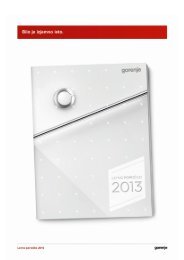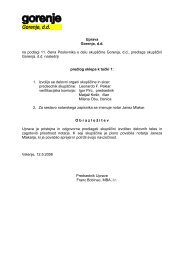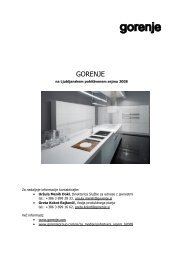ANNUAL REPORT 2008 - Gorenje Group
ANNUAL REPORT 2008 - Gorenje Group
ANNUAL REPORT 2008 - Gorenje Group
Create successful ePaper yourself
Turn your PDF publications into a flip-book with our unique Google optimized e-Paper software.
152<br />
<strong>2008</strong><br />
(iii) Investment property<br />
An external, independent valuation company, having appropriate recognised professional qualifications<br />
and recent experience in the location and category of property being valued, values the<br />
Company’s investment property portfolio every six months. The fair values are based on market<br />
values, being the estimated amount for which a property could be exchanged on the date of the<br />
valuation between a willing buyer and a willing seller in an arm’s length transaction after proper<br />
marketing wherein the parties had each acted knowledgeably, prudently and without compulsion.<br />
In the absence of current prices in an active market, the valuations are prepared by considering the<br />
aggregate of the estimated cash flows expected to be received from renting out the property. A<br />
yield that reflects the specific risks inherent in the net cash flows then is applied to the net annual<br />
cash flows to arrive at the property valuation.<br />
Valuations reflect, when appropriate: the type of tenants actually in occupation or responsible for<br />
meeting lease commitments or likely to be in occupation after letting vacant accommodation, and<br />
the market’s general perception of their creditworthiness; the allocation of maintenance and insurance<br />
responsibilities between the Company and the lessee; and the remaining economic life of the<br />
property. When rent reviews or lease renewals are pending with anticipated reversionary increases,<br />
it is assumed that all notices, and when appropriate counter-notices, have been served validly<br />
and within the appropriate time.<br />
(iv) Trade receivables<br />
The fair value of trade receivables is estimated as the present value of future cash flows, discounted<br />
at the market rate of interest at the reporting date.<br />
(v) Derivatives<br />
The fair value of derivatives is estimated as the present value of future cash flows, taking into account<br />
the market price of equivalent derivatives at the reporting date and by applying the market<br />
interest rates for equivalent derivatives at the reporting date.<br />
(vi) Non-derivative financial liabilities<br />
Fair value, which is determined for disclosure purposes, is calculated based on the present value of<br />
future principal and interest cash flows, discounted at the market rate of interest at the reporting<br />
date. In respect of the liability component of convertible notes, the market rate of interest is determined<br />
by reference to similar liabilities that do not have a conversion option. For finance leases the<br />
market rate of interest is determined by reference to similar lease agreements.<br />
5. Financial risk management<br />
In respect of financial risk management, the internal financial policies comprising the bases for efficient<br />
and systematic risk management were observed in <strong>2008</strong>. The objectives of risk management<br />
are:<br />
• to achieve stability of operations and to reduce risk exposure to an acceptable<br />
level,<br />
• to increase the value of companies and the impact on their financial standing,<br />
• to increase financial income and/or decrease financial expenses, and<br />
• to nullify and/or decrease the effects of exceptionally damaging events.<br />
In the Company, the following key types of financial risks have been defined:<br />
Financial risks<br />
Credit risk<br />
Currency risk<br />
Interest rate risk<br />
Liquidity risk

















